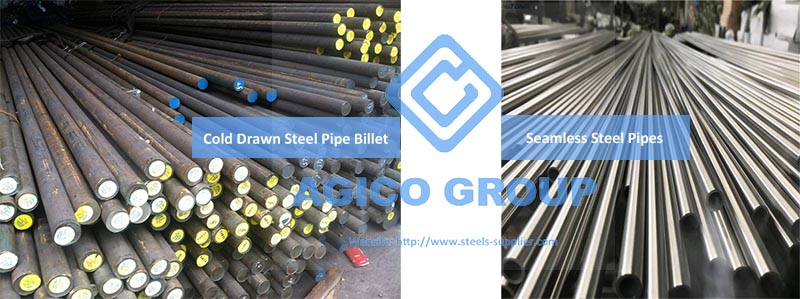
Finished or Hot Rolled, Cold Drawn Seamless Steel Pipe Use:
- Structural seamless steel pipe Billet. Including low carbon steel, medium carbon steel and alloy structural steel billet, steel grades are ASTM A53, ASTM A36, ASTM A106, ASTM A335, Din 17175, and ASTM A333.
- Boiler tube Billet. Generally, the steel for boiler tube Billets is low carbon steel and high quality carbon structural steel, such as ASME SA106, ASME SA 179, ASTM SA213, etc.
- Oil drilling and geological drilling pipe Billets. Such steel for tube Billets includes medium carbon steel, low alloy steel and alloy steel. This type of tube Billet is delivered in steel grade according to mechanical properties, and the "API" is added before the steel number, such as API 5L, API 5CT, API 5D. Fertilizer and fertilizer tube Billets. Chemical equipment and pipe transportation pipe billet steels are carbon steel, heat-resistant and acid-resistant stainless steel, such as 20#, 1Cr18Ni9Ti; petroleum cracking pipes are made of carbon steel and alloy steel, such as 10#, 20#, 12Mn2, Cr5Mo, 12CrMoV; Pipe steel has carbon steel and alloy steel, etc.
Tube Billet Requirements for Seamless Steel Pipe
Qualified tube billets are a prerequisite for the production of cold drawn seamless steel tubes. Due to the deformation characteristics of the cross-rolled perforations, strict technical requirements are imposed on the quality of the tube billet (especially the surface quality). According to the ministerial standard, there are certain technical requirements for the size, surface quality and organization of the Billets made of high-quality round steel.
-
Geometrical dimensions and allowable deviations of cold-drawn seamless steel tube billets: tube billet diameter and allowable deviation: the allowable deviation is +1.0 -0.5 mm when the tube billet diameter is 75 mm; the allowable deviation is when the tube billet diameter is 80-90 mm +0.8 - 1.3 mm; the allowable deviation is +1.0 - 1.7 mm when the tube billet is 95 to 120 mm in diameter.
Tube length: generally 2.3~6 meters (according to mutual agreement).
Bending: The local bending is not more than 10 mm per meter without straightening equipment, and the total bending is not more than 1.0% of the total length.
Tube Billet head chamfer: when the diameter of the tube is not more than 96 mm, the inclination is less than 6 mm; when the diameter of the tube is 95 to 120 mm, the inclination is less than 8 mm.
The surface roughness Ra of the tube Billet after peeling or molting was 25 μm.
When the above tolerance is exceeded, not only the perforation biting condition is deteriorated, but also the perforation quality and the rolling mill adjustment are directly affected. - The surface quality of the precision cold drawn seamless steel tube Billet directly affects the outer surface quality of the finished precision cold drawn seamless steel tube. In the production of hot-rolled seamless steel tubes, the surface condition of the tube Billets must first be strictly checked. The outer surface of the tube Billets is not allowed to have crusting, cracks, cracks, grooves, folds, dents, ears, pores, and hemp. Defects such as spots, blisters and non-metallic inclusions. When the depth of the defect exceeds 0.7~1.0 mm, the defect cannot be burned off with the heating of the tube Billet, but any defects remaining on the surface of the tube Billet will expand during the deformation of the tube, so that any defects on the outer surface of the tube will be During the process of wear and rolling deformation, the defects are deepened and lengthened on the outer surface of the steel pipe, resulting in waste. The above partial defects should be cleaned up in time, but the defect processing depth is not allowed to exceed 5% of the tube Billet diameter.
- Tube Billet low-fold organization. The internal quality of cold drawn seamless steel tube Billets is generally based on the low-fold organization of the tube billets. The low-fold structure of the tube Billet should not have visible shrinkage, tumbling, delamination, bubbles, blisters, non-metallic inclusions, white spots and cracks, etc., which are visible to the naked eye.
- The microstructure of the tube Billet. For the production of special requirements for alloys and high-alloy cold-drawn seamless steel tubes, in addition to inspection of low-magnification, the microstructure (ie metallographic high-magnification) inspection should be carried out to determine non-metallic inclusions (such as The content and distribution of sulfides, oxides and carbides, and the identification of banded structures and decarburized layers.
At the time of delivery, special attention should be paid to the above aspects, especially if the wall thickness of the tube billet is not uniform, and the tube bllet with trachoma should not accepted, so as to avoid misleading the precision seamless steel pipe or cold drawn seamless steel pipe produced and processed later, and such unnecessary troubles.


